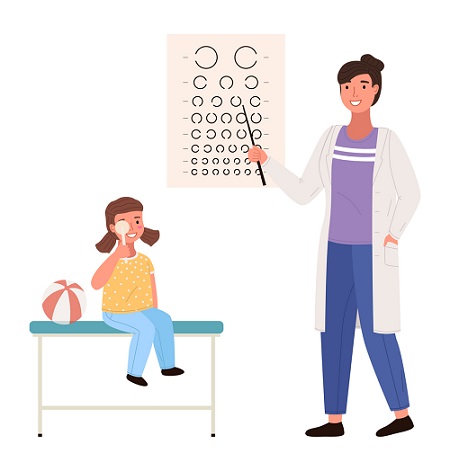
Everyone understands that the eyes are essential. However, people do not want to visit the ophthalmologist unless there is a specific problem. However, many children have vision problems and eye damage due to smartphone exposure from a very young age. Experts emphasize that eye examinations received during health check-ups for infants and young children are insufficient. Moreover, eye examinations should be prompted immediately after birth and maintained regularly. With the new school year approaching, we tried to answer children's eye health questions.
■When should I start my child's eye exam?
Essential visual functions such as vision, color vision, and stereopsis begin to develop rapidly from around three months of age and then go through the development process from 7 to 12 years of age. Children's visual skills expand much earlier than we think. Therefore, it is recommended to start the eye examination right after birth.
Professor Jang Ji-woong of Inje University Ilsan Paik Hospital expressed, "Eyes are usually examined at the health check-up for infants after four months of age. But it could be too late to detect congenital eye diseases if there are any. Furthermore, since ophthalmologists do not provide the regular health check-up for infants, there is a limit to early detection of eye diseases."
He continued, "The first year after birth is the most critical period for visual development. We recommend visiting an ophthalmologist ▲immediately after birth ▲Three months after birth ▲at the age of 3 and every six months for examination after three years of age." Many developed countries, such as the US, UK, and France, require regular eye exams right after birth, starting from the newborn period.
■Why should nonverbal infants have an eye exam?
Of course, infants do not speak immediately after birth, so they cannot read and name the numbers on the sight board. However, the examination from this period is to determine whether the eyes are developing typically and whether other diseases such as congenital eye diseases, strabismus, and refractive errors interfere with normal visual development. So, you shouldn't hesitate to get your baby's eyes checked just because your child is speechless.
Visual acuity is measured when the child can name the pictures on the sight plate. Each child is different, but most can try it from around the age of 3 years old.
■How do smartphones damage eyes?
Children these days are exposed to electronic devices such as smartphones and tablet PCs from a very young age. Focusing on one place for an extended period causes myopia and greatly harms children's eye health.
Nearsightedness (myopia) is a common vision condition in which you can see objects near to you clearly, but objects farther away are blurry. It occurs when the shape of your eye causes light rays to bend (refract) incorrectly, focusing images in front of your retina instead of on your retina. It has been reported that exposure to smartphones or tablets promotes myopia's development and progression. Also, when even one of the parents has myopia, the probability increases, so more careful management is required.
Decrease in outdoor activities with prolonged use of electronic devices also affects the occurrence of myopia. A study reports that increasing dopamine secretion in the body, when exposed to sunlight, prevents myopia. Therefore, it is necessary to minimize the time spent using the electronic device and rest the eyes by looking at a distant place after using the device for a certain time. It is also a great way to get out in the sun through outdoor activities with your child.
■Are glasses for children at an early age the best option?
A child found to be nearsighted should wear glasses for correction. Lee Byung-joo, a pediatric ophthalmologist at Asan Medical Center Children's Hospital in Seoul, stated, "As children grow, their eyeballs grow longer, so if left untreated, myopia can only get worse," He added, "It is important to wear glasses at the right time because they create a clear retinal image and stimulate visual development."
When choosing glasses, you should assess the functional aspect rather than the shape. Children still have a low nose bridge and short length from the ears to the front of the face so that the glasses can slide down easily. Also, it is more reasonable to consider the weight of the lenses rather than just trying on the frames.
Professor Jang Ji-woong expressed, "Considering the face shape of children and the weight of the lenses, parents should choose glasses that do not fall off." "Because children's refractive values change frequently, it is adequate to change the lenses frequently through regular check-ups than to get too expensive glasses from the beginning," he advised.
■Should strabismus be treated with surgery?
Strabismus, out of focus in both eyes, is a typical pediatric eye disease and adversely affects children's visual development, so early diagnosis and treatment are essential. If your children show symptoms such as ▲ your children are looking at me, but it doesn't look like they are looking at me, ▲ their eyes feel dazed ▲ their eyes look strange when they are thinking or when they are sleepy.
However, strabismus does not necessarily require surgery. Depending on the type, shape, cause, and degree of the disease, you can observe the treatment progress while wearing glasses or using non-surgical methods such as masking treatment. However, if surgery is necessary, it is most satisfactory to receive it at the optimal time possible.
■Do cataracts occur in children?
Many people believe that cataracts are eye diseases that occur with aging, but cataracts can develop from birth or develop after birth.
Cataracts in children can develop in one or both eyes. There are often no symptoms if it occurs in only one eye because it quickly adapts to seeing with the other eye. If it occurs in both eyes, the symptoms may differ depending on the time of onset. If there is a congenital cataract in both eyes, there is no time for normal vision development, so patients may not be able to focus or show eye tremor. If cataracts occur in both eyes after a certain vision development period, they suddenly act as blind.
Pediatric cataracts can also be identified with the naked eye. If the inside of your child's pupils appears gray or white, you should suspect that he or she may have a congenital cataract. Professor Jang Ji-woong said, "However, this phenomenon can also occur when there is a tumor in the eye." He emphasized, "If the inside of the pupil looks white when looking at the child's eyes, an eye examination should be performed without delay." If the lens opacity is severely cloudy due to a pediatric cataract, surgery is required as soon as possible.


